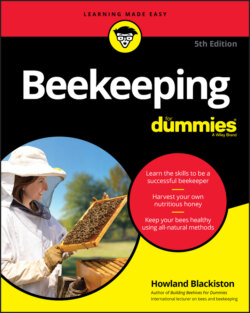Читать книгу Beekeeping For Dummies - Howland Blackiston - Страница 18
WHY BEES MAKE GREAT POLLINATORS
ОглавлениеAbout 100 crops in the United States depend on bees for pollination. Why is the honey bee such an effective pollinator? Because she’s uniquely adapted to the task. Here are several examples of bee adapations:
The honey bee’s anatomy is well suited for carrying pollen. Her body and legs are covered with branched hairs that catch and hold pollen grains. The bee’s hind legs contain pollen baskets that the bee uses for transporting pollen, a major source of food, back to the hive. If the bee brushes against the stigma (female part) of the next flower she visits, some of the pollen grains brush off, and the act of cross-pollination is accomplished.
Most other insects are dormant all winter. They initialy emerge in spring only in small numbers until increasing generations have rebuilt the population of the species. Not the honey bee. Its hive is perennial. The honey bee overwinters with large numbers of bees surviving on stored honey and pollen. Early in the spring, the queen begins laying eggs, and the already large population explodes. When flowers begin to bloom, each hive has tens of thousands of bees to carry out pollination activities. By midsummer, an individual hive contains upward of 60,000 bees.
The honey bee has a unique habit that’s of great value as a pollinator. It tends to forage on blooms of the same kind, as long as they’re flowering. In other words, rather than traveling from one flower type to another, honey bees are flower constant. This focus makes for particularly effective pollination. It also means that the honey they produce from the nectar of a specific flower takes on the unique flavor characteristics of that flower — that’s how we get specific honey flavors, such as orange blossom honey, buckwheat honey, blueberry honey, lavender honey, and so on (see Chapter 15 for a lesson in how to taste and evaluate honey varieties).
The honey bee is one of the only pollinating insects that can be introduced to a garden at the gardener’s will. You can garden on a hit-or-miss basis and hope that enough wild bees are out there to achieve adequate pollination — or you can take positive steps and nestle a colony of honey bees in a corner of your garden. Some commercial beekeepers make their living by renting colonies of honey bees to farmers who depend on bee pollination to raise more bountiful harvests. Known as migratory beekeepers, they haul hundreds of hives across the country, following the various agricultural blooms — to California for almond pollination in February, to the apple orchards in Washington in April, to Maine in May for blueberry pollination, and so on.
I’ve witnessed the miracle in my own garden: more and larger flowers, fruits, and vegetables — all the result of more efficient pollination by bees. After seeing my results, a friend who tends an imposing vegetable garden begged me to place a couple of hives on her property. I did, and she too is thrilled. She rewards me with a never-ending bounty of fruits and vegetables. And I pay my land-rent by providing her with 20 pounds of honey every year. Not a bad barter all around.
